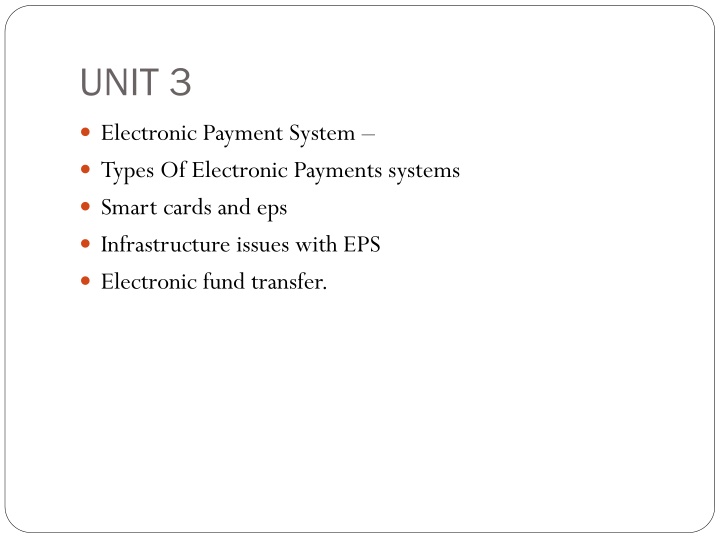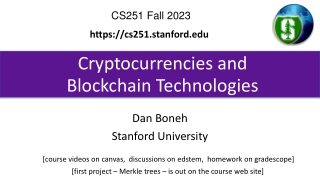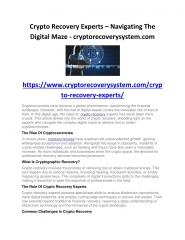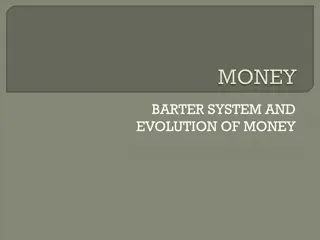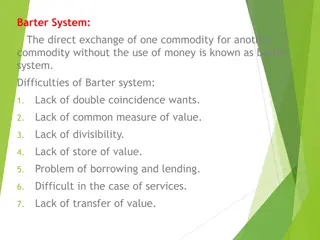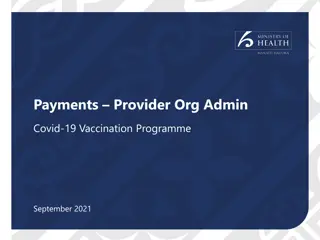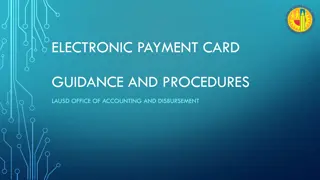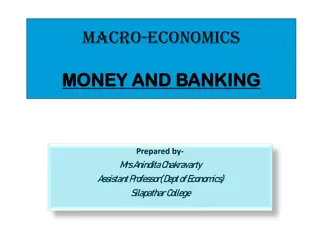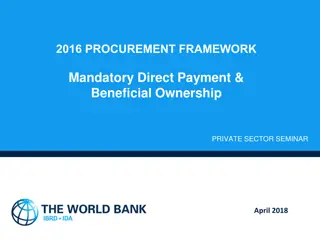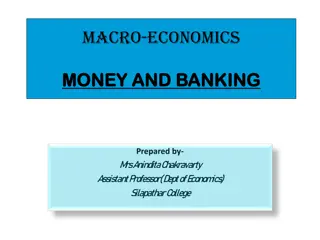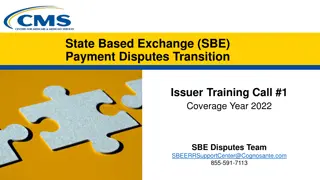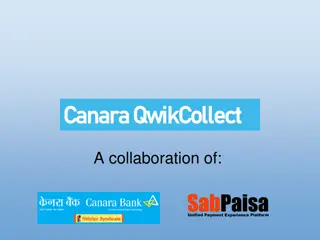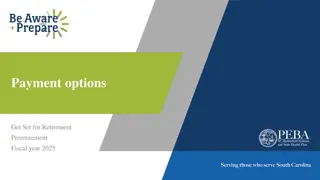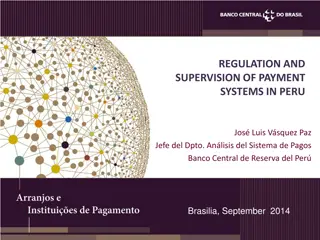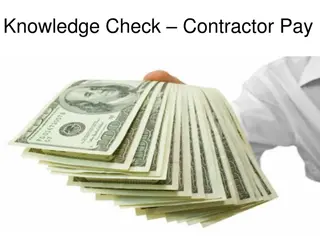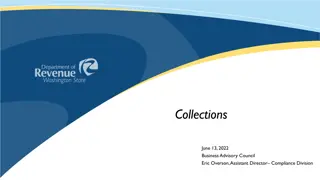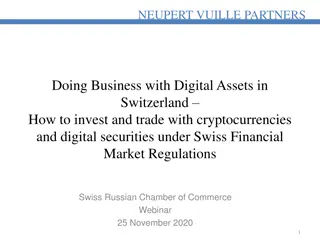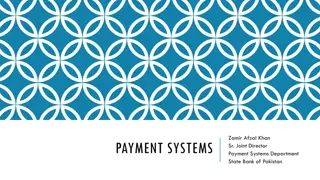Evolution of Electronic Payment Systems: From Barter to Cryptocurrencies
The evolution of payment systems has come a long way, from the barter system in ancient times to the modern era of cryptocurrencies and digital payments. This journey includes the invention of coins, paper money, banknotes, cheques, credit cards, and the latest digital payment methods. The impact of Covid-19 has further accelerated the shift towards electronic payments, changing the way we transact globally.
Download Presentation

Please find below an Image/Link to download the presentation.
The content on the website is provided AS IS for your information and personal use only. It may not be sold, licensed, or shared on other websites without obtaining consent from the author.If you encounter any issues during the download, it is possible that the publisher has removed the file from their server.
You are allowed to download the files provided on this website for personal or commercial use, subject to the condition that they are used lawfully. All files are the property of their respective owners.
The content on the website is provided AS IS for your information and personal use only. It may not be sold, licensed, or shared on other websites without obtaining consent from the author.
E N D
Presentation Transcript
UNIT 3 Electronic Payment System Types Of Electronic Payments systems Smart cards and eps Infrastructure issues with EPS Electronic fund transfer.
LETS UNDERSTAND WHAT IS PAYMENT SYSTEM LETS UNDERSTAND WHAT IS PAYMENT SYSTEM AND ITS EVOLUTION AND ITS EVOLUTION The new reality arising from Covid-19 has impacted the whole society. In many countries, the new normal involves wearing a mask in public places and keeping social distance. The way we pay for products or services has also been affected by the pandemic: many establishments began to recommend payment through electronic means, whether by card, digital applications or using contactless payment systems,such as Google Pay or Samsung Pay. There are many alternatives available today, but this wasn t always the case. Payment methods have evolved over the centuries to give us the many options we have in the present day.
How have payment methods evolved and how did the first transactions take place? Buying things and paying for them is something that is part of our everyday lives nowadays, and we do it several times a week. But how did we get to the situation we know today? Here s a review of the main milestones: BARTER COINS PAPER MONEYAND BANK NOTES BILLS OF EXCHANGEAND CHECKS CARDS DIGITAL PAYMENTS CRYPTOCURRENCIES 1. 2. 3. 4. 5. 6. 7.
1. Barter: Barter is exchange of material goods or services for other goods or services. Evidence of the existence of a barter system goes back to the Neolithic, starting with the emergence of the agricultural/livestock society (probably before 7000 BC). 2. Coins: The use of coins escalated because barter sometimes posed difficulties for transactions, and certain forms of payment were perishable, so they could not be accumulated. The result was the emergence of coins made of precious metals. A circular shape was adopted as being the most practical. Their first appearance dates from approximately 680 to 560 BC,in what it is nowTurkey. 3. Paper money and banknotes: Their function was to replace coins, because it was uncomfortable to carry coins in large quantities. Banknotes were first used in China in the 7th century,but it was not until 812 that their use became official. 4. Bills of exchange and cheques: Bills of exchange date back to 12th-century Italy. This document guaranteed that the debtor would pay the creditor or another person authorised to receive the money in the commercial document.The origin of cheques,on the other hand,dates back to around the 18th century,and is linked to the English Crown.
5. Cards: The first credit cards arrived in 1914, when the Western Union company created a loyalty card for its most exclusive customers, giving them access to a line of credit without surcharges. However, only from 1958 that banks started to offer cards as a payment solution. The first card later came to be known asVisa. 6. Digital payments: With the arrival of the Internet and the World Wide Web system in 1990, goods and services began to be sold through this new communication channel. One of the pioneers was the company Peapod, which offered the possibility of buying groceries from home via a computer. After the disrupted digital revolution of recent years, and with the introduction of new technologies,it is now possible to pay by mobile phone or digital watch. 7. Cryptocurrencies: in 1998, Wei Dai proposed the idea of creating a decentralised type of currency, which would be based on cryptography as a means of control.This gave rise to the concept of crypto currency. The first attempts to create a currency were made by David Chaum, using DigiCash and eCash. However, it was not until 2009 when, Satoshi Nakamoto (pseudonym), created the first cryptocurrency, called bitcoin.
HOW DO WE DEFINE PAYMENT SYSTEM? A payment system is any system used to settle financial transactions through the transfer of monetary value. This includes the institutions, instruments, people, rules, procedures, standards, and technologies that make its exchange possible.
ELECTRONC PAYMENT SYSTEMS (EPS) Issues of trust and acceptance play a more significant role in the e-commerce world than in traditional businesses as far as payment systems are concerned. Traditionally, a customer sees a product, examines it, and then pays for it by cash, check, or credit card . In the e-commerce world, in most cases the customer does not actually see the concrete product at the time of transaction, and the method of payment is performed electronically. Payment Credit Card, Check CUSTOMER BUSINESSMAN Product / Surveys
While customers pay for goods/services by cash, check, or credit cards in conventional businesses, online buyers may use one of the following EPSs to pay for products/services purchased online: 1. Electronic funds transfer (EFT): EFT involves electronic transfer of money by financial institutions. 2. Payment cards : They contain stored financial value that can be transferred from the customer's computer to the businessman's computer. 3. Credit cards : They are the most popular method used in EPSs and are used by charging against the customer credit. 4. Smart cards: They include stored financial value and other important personal and financial information used for online payments. 5. Electronic money (e-money/e-cash): This is standard money converted into an electronic format to pay for online purchases. 6. Online payment: This can be used for monthly payment for Internet, phone bills, etc. 7. Electronic wallets (e-wallets) : They are similar to smart cards as they include stored financial value for online payments. 8. Micro-payment systems : They are similar to e-wallets in that they include stored financial value for online payments; on the other hand, they are used for small payments, such as kurus in Turkey . 9. Electronic gifts : They are one way of sending electronic currency or gift certificates from one individual to another. The receiver can spend these gifts in their favorite online stores provided they accept this type of currency.
E-payment types include ACH, wire and bank transfers, cards, digital wallets, mobile pay and more. Any number of different factors can guide businesses toward the type or types of electronic payment that might work optimally for them and their vendors.
COMPONENTS OF A CREDIT / DEBIT CARD A debit card has the following details: THE CARD NUMBER: this is a 16- digit number. The card number is unique and is not the same as the bank account number. THE ISSUE AND EXPIRATION DATE: The issue date is also printed in the MM/YY format. The expiry date is also printed in the same MM/YY format. THE LOGO: The card has the logo of the bank that has issued it. It also has the logo which determines the type of debit card it is: Visa, Mastercard or RuPay logo. CHIP - A chip card has a microchip embedded in the debit card. It is very difficult to tamper with a chip. This is an additional security measure. A chip-based card can prevent fraudulent transactions from taking place. As per the present RBI guidelines, it is mandatory for all banks to issue chip-based cards. WIFI SYMBOL - The Wi-Fi-looking symbol on a debit or credit card is the EMVCo Contactless Indicator*. It indicates that your card can be used to tap to pay on a contactless-enabled payment terminal. CUSTOMER SERVICE NUMBER: The toll-free number is printed on the back of the card. You can call this number in case of any questions or to report the loss or theft of your card. THE SIGNATURE BAR: A signature bar is provided on the back of the card. It is important that you sign the bar as soon as you receive the card. This can help you to prevent fraudulent transactions. Some merchant retail outlets do not swipe the card unless the signature is verified. CVV number: Also known as the card verification value number, the CVV number is unique to every debit. This number needs to be provided at the time of making online payments. It provides an additional layer of security to the card. GRID NUMBER is an additional feature offered by ICICI bank along with their Debit card and it is important for you that you should not share the debit card details with anyone so as to ensure that there are no unauthorized transactions from your debit card.
Electronic Payment Types: Advantages and Disadvantages CREDIT CARDS A 2019 study conducted by the Federal Reserve noted that consumers paid with cash in 26 percent of transactions, as opposed to debit cards for 28 percent of payments and credit cards for 23 percent of payments.
Advantages and Disadvantages of Credit Card Advantages - 1. They re a Great Way to Build Credit Your credit history is your track record of borrowing money and paying it back. Each time you open a new credit card account, the lender reports that activity to a credit reporting agency. They ll also report if you miss a payment or are frequently late paying your monthly installments. Your credit history determines your credit score, which ultimately lets lenders know whether you re a good candidate for a credit card or loan and which parameters to assign you (i.e., your interest rate and credit limit). Good credit can improve the quality of your life and get you closer to your financial goals if used responsibly. 2. They re More Secure Than Cash - Credit cards are used frequently even by people who have access to cash because they offer another level of security. If you lose a credit card or someone steals your information, the credit card company can place a hold on it to avoid fraudulent purchases. Additionally, many credit card companies monitor suspicious activity and will notify you if something seems inconsistent with your typical spending behavior. 3. Rewards Points - Many credit card companies offer rewards such as cash back or airline miles for using them regularly. If you use a credit card for routine expenses, these rewards can add up quickly. Though many rewards cards come with annual fees, the benefits you can accrue over the course of a year can more than offset the cost of keeping the card open.
Advantages and Disadvantages of Credit Card Dis - advantages - 1. High Cost of Borrowing - Although credit cards are convenient, the cost of borrowing is typically much higher than with a traditional loan. Many come with high APRs (the annual interest rate charged on borrowed funds), service fees, and penalties for late payments. If you don t pay your balance off every month, these additional finance charges can quickly grow your existing debt. Additionally, many credit cards allow you to get a cash advance if you need cash quickly but the interest rate charged on these advances is typically even higher than for purchases. 2. It s Easy to Dig Yourself into a Hole - Depending on your credit limit, a new credit card may suddenly give you access to more funds than you ve had in the past, making it easy to overspend if you are not disciplined. To avoid digging yourself into a hole and potentially damaging your credit and financial health, it s important to only spend what you can reasonably afford to pay back each month. If you don t already have a budget, making one can help you stay on track, so you don t accumulate too much debt. 3. Applying for Too Many Credit Cards Can Damage Your Credit Several factors impact your credit score, including payment history, current amount owed, length of history, new credit, and types of credit used. While having a few cards that you use regularly and pay back on time can help you build and improve your credit, there s a limit to how many cards you should reasonably open. Each time you apply for a new credit card account, lenders can check your credit report to assess your credit worthiness. Not only can too many card applications negatively impact your credit score, lenders may get suspicious if it looks like you need access to a lot of credit and reject your application.
Advantages and Disadvantages of Debit Card Advantages - 1. Debit card can be easily obtained: When you open a savings or current account, most banks issue a free debit card. Make sure that you fill in the necessary documentation to receive your debit card. 2. Very convenient to use: One of the advantages of a debit card is that it can be swiped for transactions as well as withdrawal of cash from ATMs. 3. No more debts: When you have a credit card, you are more likely to make impulsive purchases. But a debit card keeps you in check as it is linked to your bank account. You are only able to spend the amount that is in your account. You don t have to worry about the mounting credit card bills anymore. 4. Easily accepted: Debit cards are accepted widely all over India and at international destinations. Make sure to authorise international transactions by simply calling your bank. These debit cards can be used for cash withdrawal at international ATMs too. So you don t have to carry cash with you when you are travelling. 5. Earn rewards: Offers are not restricted to credit cards alone. Using your debit card too can help you gain rewards and cashbacindia offers. Several online and retail outlets offer cashback offers for every purchase made on the debit card. The points can be redeemed at any time to either purchase products from an online catalogue of the bank or to earn shopping vouchers from various brands.
Advantages and Disadvantages of Debit Card Disadvantages - They have limited fraud protection. According to the Federal Trade Commission, if your debit card is stolen and you notify your bank within two days, you could be responsible for up to $50 of any fraudulent charges. If you notify your bank after two business days, you might be responsible for up to $500 of the fraudulent charges. Notifying your bank after 60 days means you could be liable for all of the fraudulent charges. Because debit cards typically have less fraud protection than credit cards, it s best not to use your debit card for online purchases. Your spending limit depends on your checking account balance. A debit card is a good option for smaller purchases, but it s not the best option for large expenses that exceed your account balance or that you d rather pay off over time. While it s ideal to budget for large expenses, a credit card is another way to help you afford them. They may cause overdraft fees. With a debit card, it s possible to overdraw funds from your account if you don t keep close tabs on your checking account balance. Overdraft consent enables these transactions to occur by charging a fee. You can opt out of overdraft consent, but this means your debit card will be declined for purchases you can t afford. They don t build your credit score. Since debit cards are directly linked to your checking account, they don t affect your credit score. If you re looking to build your credit history, debit cards won t help.
EMV is a payment method based on a technical standard for smart payment cards and for payment terminals and automated teller machines which can accept them. EMV is short for Europay, MasterCard, and Visa, the three companies that created the standard - the 1994 founders. It commonly refers to a credit card with a smart chip. The EMV standard is a security technology used worldwide for all payments done with credit, debit, and prepaid EMV smart cards. The EMV Contactless Specifications refer to transactions using proximity NFC payment devices. These devices allow transactions to be made by waving or tapping on an EMV Contactless enabled terminal. Please note that in India, payment through contactless mode is allowed for a maximum of Rs.2000/- for a single transaction where you are not asked to input your Debit Card PIN.No PIN is required for amounts less than Rs.2000.
Debit cards Credit cards Convenient and widely accepted No annual fees Can help with budgeting Interest-free Short-term financing option Can build your credit history May offer cashback rewards Strong fraud protection Pros Limited fraud protection Spending limit depends on checking account balance Possible overdraft fees Don t build your credit Danger of overspending Interest payments Late payment fees Can hurt your credit score Cons
Digital Wallet Digital Wallet Digital wallets are becoming ubiquitous. The 2019 Payment Methods Report noted that in a recent year, nearly 30 billion payments were made with eWallets, or close to four for every person in the world.
Advantages and Disadvantages of Digital wallet Advantages Already extremely popular, digital wallet use should continue to increase with further broadband availability in rural and developing areas. The bustling Internet of Things, or IoT revolution currently underway also means that more payment systems will likely come online in years to come. What this means for accounts payable is that they ll likely have vendors willing to accept more and more payment forms as they start to adopt these emerging payment methods. Disadvantages Digital wallets are more focused on B2C and point of sale transactions, but it s not to be said digital wallets can t be used for B2B. Things to consider for B2B would be how the reconciliation process works and if vendors accept payment by means of the method in the digital wallet. Moreover, digital wallets often require your vendor to get on board with the system or app.
Automated Clearing House Automated Clearing House (ACH) (ACH) People might be familiar with the Automated Clearing House, or ACH as the method for direct deposit of paychecks, with more than 90 percent of workers preferring to get paid this way. But employee direct deposit is not the only use for the ACH. ACH payments are US-based bank-to- bank transfers that are aggregated and processed in batches through the Automated Clearing House (ACH) network, run by NACHA (National Automated Clearing House Association), and is common for B2B payments.
ACH Participants ACH Participants All parties involved in an ACH transaction must follow NACHA rules. The five ACH participants are: 1. Originator: It refers to the party initiating the electronic payment. It can be an individual, a company, or a government agency. The receiver authorizes it to make the payment. 2. ODFI: It is the abbreviated form of Originating Depository Financial Institution. It receives instructions from the originator in the form of a NACHA file and facilitates transactions accordingly. 3. ACH Operator: It operates and takes care of clearing facilities. There are two major ACH operators in the U.S. the Federal Reserve and the Clearing House (Electronic Payment Network). 4. RDFI: Also known as Receiving Depository Financial Institution, it is the one which the originator authorizes to receive the electronic payment. It credits the amount to the receiving account. In the event of a return, the RDFI acts as the ODFI. 5. Receiver: It is the receiving party and can be an individual, government agency, or company.
Example Example Let us consider the following examples to understand the working of NACHA well: Katherine receives her salary on the 1st day of every month. Accordingly, she plans her monthly installment payments, including her bill payments. Even a day s delay could lead to problems for her as she will not be trusted by her debtors if she missed paying them on time. Luckily, the company she works with operates over the ACH network controlled by NACHA. It ensures same-day payment directly to employees accounts without delays. As a result, Katherine rest assured of not missing out on paying whoever she owes an amount to every month. It is how the National Automated Clearing House Association efficiently directs credit and debit transactions over the ACH network.
